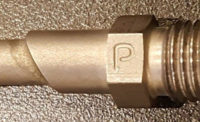Trends in CT Scanners
Metrology companies take a longer look at computed tomography

A CT scan of a metal casting is inspected for porosity. Source: Jesse Garant and Associates









Computed tomography (CT) scanners are a popular choice for inspecting both the external and internal geometry of parts — finding inclusions, voids and flaws that could cause failure or under performance.
In recent years, new CT scanners built specifically for measurement have generated new interest in the machines from metrology companies.
“You’ve always been able to use a CT scanner for metrology, but the trend over the past several years has been to market metrology specific CT systems so that they, in some ways, mimic more of a CMM or a vision system,” says Jim Clark, Nikon Metrology, vice president of strategic marketing and business development, X-Ray products. “They’re more in line with the type of job that you’d expect to see in a quality lab. And metrology companies began to realize that there was a marketplace that’s perhaps not being addressed.”
How It Works
CT scanners work by placing an object on a turntable between an x-ray tube and a detector. The detector captures multiple x-ray images of an object as it rotates 360 degrees, acquiring the outer dimensions, internal geometry and density within the object’s walls. The series of 2D images are then run through a reconstruction algorithm that creates a 3D volumetric model, built from billions of voxels. Each voxel is a 3D cube with a discrete x-y-z location and density.
The digital model can then be sliced and diced, inspected, compared to CAD models, measured, checked for wall thickness and porosity or run through myriad other processes.
Use in Measurement
To use a traditional industrial CT scanner for measurement, it is calibrated relative to the scale of each new part being inspected. This is still a popular way for many to measure with CT scanners. But for metrology houses looking for certified measurements and less per-project set-up, metrology CT scanners that only require calibration during the initial installation have obvious appeal.
Exact Metrology President Steve Young says the advent of metrology-specific CT scanners created the incentive for his company to invest in its first machine this winter.
“We just kept seeing people asking us for stuff that we couldn’t do in our conventional way,” Young says. “It kept coming back to CT scanning. It was kind of the perfect storm, as a lot of customers were asking for this, and then they came out with a metrology-calibrated system. So we said ‘OK, it’s time to put two and two together.’”
In addition to measurement, Exact Metrology also uses the scanner for traditional CT inspections like void analysis, reverse engineering, part-to-CAD and fiber analysis.
“We just inspected an aluminum casting, and they were having some failures with one area of it,” Young says. “We scanned it, and we can show them the porosity inside the casting. And it was very evident to them why that area was having a failure. Being able to give them an actual location — x,y,z location and volume, and the size of porosity inside the casting — that was critical for them.”
Despite the new interest from metrology companies, Clark says using CT scanners for measurement is still a small part of the overall marketplace.
“I would say the vast majority of the people who come through our doors are not necessarily looking for metrology-certified measurement,” he says. “They’re looking for … an extremely detailed look at what’s going on inside their object. They’re also not always looking at the diameter of a hole or roundness of a circle; we can obviously measure all those things quite easily. But they’re often looking at are there any inclusions in their object? If it’s a plastic object, do they have voids, or porosities, as we call it?”
As described above, buying a metrology-specific machine is not the only way to perform measurements with a CT scanner. Jesse Garant and Associates runs several CT scanners and specifically calibrates its machines on an inspection-by-inspection basis when precision measurements are needed.
“Typically, we’re seeing a lot of value-added parts, so you’re getting into your castings, your plastic parts inspections, your assemblies, your component validation,” company President Jesse Garant says. “If you find the right parts that can be CT scanned properly, you’re going to see about a 25-30 percent cost savings on average for validating these parts, for dimensionality and internal characteristics, as well, and a lot faster than you would traditionally.”
Both Garant and Young said there is often a good amount of education required for new potential customers.
“There’re two types of clients that we see,” Garant says. “We have some clients who utilized CT in the past in various degrees. Either they’re familiar with the medical side, or used CT maybe 10, 15 years ago on the industrial side, where the resolution, the scan speeds and the processing capabilities have really (improved) over time.
“The other clients coming in are the uneducated side where it’s a new tech to them, where we need to really kind of start from the beginning on the metrology aspect, relating what radiography is.”
Garant says he expects to see manufacturers in the future offer more uniformity in CT scanners, along with continuing the trend of calibrated machines.
“Everyone is trying to hone in on the proper equipment to sell to different industries,” he says. “And there are so many different industries out there, and there are so many different machine configurations out there. I think we’re going to start seeing the machine side shrink over time to a very specific envelope because larger CT machines cost more money. We’re probably going to see more calibrated systems coming out that check parts for a certain envelope of a certain material. That would allow CT to start becoming more mainstream in inspection.”
Looking for a reprint of this article?
From high-res PDFs to custom plaques, order your copy today!











